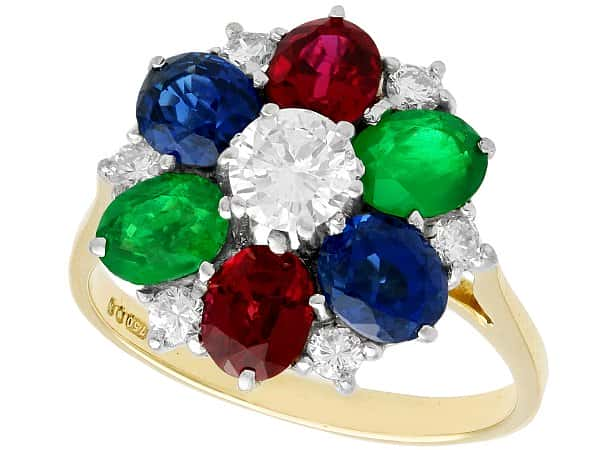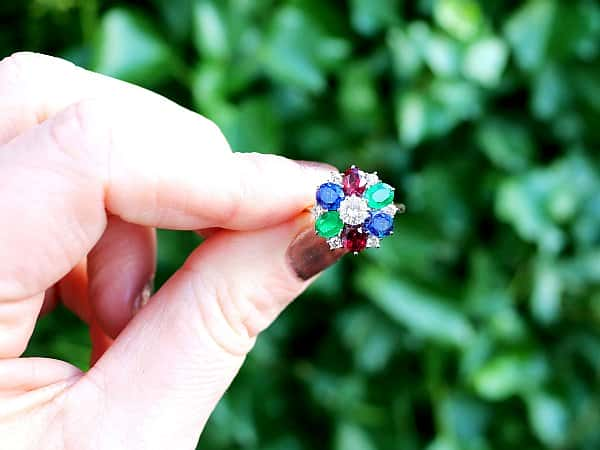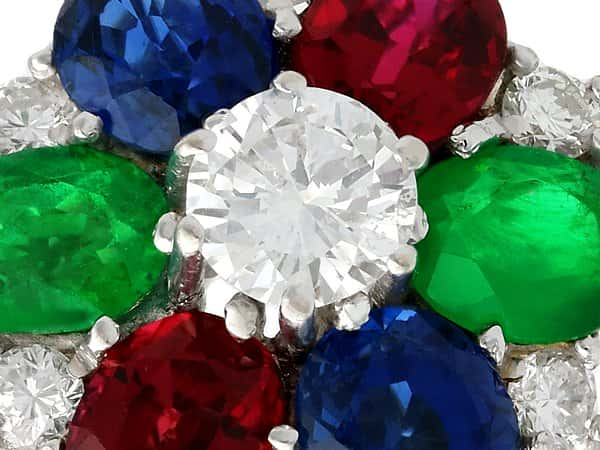What Is a Dearest Ring?
Victorian jewellery is known today for its romanticism. Themes like flowers and hearts are commonly found throughout jewellery pieces from this era. An underserved and underrepresented element of Victorian jewellery, however, is the acrostic ring. These rings featured gemstones that spelled out specific terms, and were often given to lovers as a symbol of one's devotion.
The dearest ring is one such acrostic ring. Each letter of the word is physically represented by a gemstone, with the most common formation being: diamond, emerald, amethyst, ruby, emerald, sapphire, tourmaline. Sometimes, however, the amethyst and the tourmaline are swapped out for alexandrite and topaz.
Since the usage of acrostic rings is scarcely documented, it is largely unknown when they first became popular, although it is believed to be some time in the 1820s. With this said, the acrostic ring is not technically a Victorian invention, but it was certainly the Victorians who adored the design and utilised it most. Acrostic rings were popular throughout the Victorian period and even into the early Edwardian period. It seems that – as with a lot of Victorian fashion and design – the acrostic ring was quickly considered 'old-fashioned' and fell to the wayside with the rise of Art Deco design in the early 20th century.
There are other forms of acrostic ring apart from the dearest ring. Regards and adore are two other designs that used gemstones to spell their affections. Typically, a regards ring was comprised of: ruby, emerald, garnet, amethyst, ruby, diamond, and sapphire. An adore ring, on the other hand, included: amethyst, diamond, opal, ruby, and emerald.
Perhaps because of their design as a coded, acrostic message, the most common format for these rings was to have all of the gemstones in a straight horizontal line across the band of the ring. The display of colour created by this format is deceptively modern-looking, and many contemporary jewellers have imitated the style, using gemstones to spell more modern affectionate terms.
Some designs, however, were more typical of the Victorian era, placing them gemstones in a more circular pattern and forming a flower of sorts. Often a pearl would be placed at the centre of this layout, although sometimes – in a dearest ring – the diamond would take centre stage. With this formation, it would appear that acrostic rings like the dearest ring are some of the earliest forms of diamond engagement rings for 'commoners' found in Western culture.
The first documented diamond engagement ring was used in 1477 by Archduke Maximillian of Austria, and there were likely earlier examples, but common, everyday people didn't use diamond engagement rings until the late 1940s. It is important to note, however, that dearest rings were not given as part of a proposal of marriage. Instead, they were romantic gifts that were typically given in the early stages of a relationship.
Retrospectively, we are able to look back and see how the use of dearest rings could be a precursor to the diamond engagement ring that is commonplace today, but to the Victorian people it was more like a modern promise ring. Most couples who exchanged something like a dearest, regards, or adore ring did surely marry, but they were not betrothed over the gift itself.
Today, many look to the antique design as a unique and indeed beautiful gift to give to their loved ones. Commissioned acrostic rings allow the customer to choose their message as well as their gemstones, resulting in creative and individualistic gifts. It is true that many Victorian practises seem outdated and bizarre by today's standards, but the acrostic ring is certainly not one such practise.
Sometimes, Dearest rings have a more common ring layout, with the stones in a pattern around a central stone like modern cluster rings
Commonly Spelled Out Gemstone Acrostics:
| Acrostic | Gems |
|---|---|
| Regard | Ruby Emerald Garnet Amethyst Ruby Diamond |
| Dearest | Diamond Emerald Amethyst Ruby Emerald Sapphire Topaz |
| Adore | Amethyst Diamond Opal Ruby Emerald |
| Love Me | Lapis Opal Vermeil Emerald Moonstone Emerald |
| Forever | Fire Opal Opal Ruby Emerald Vermeil Emerald Ruby |





